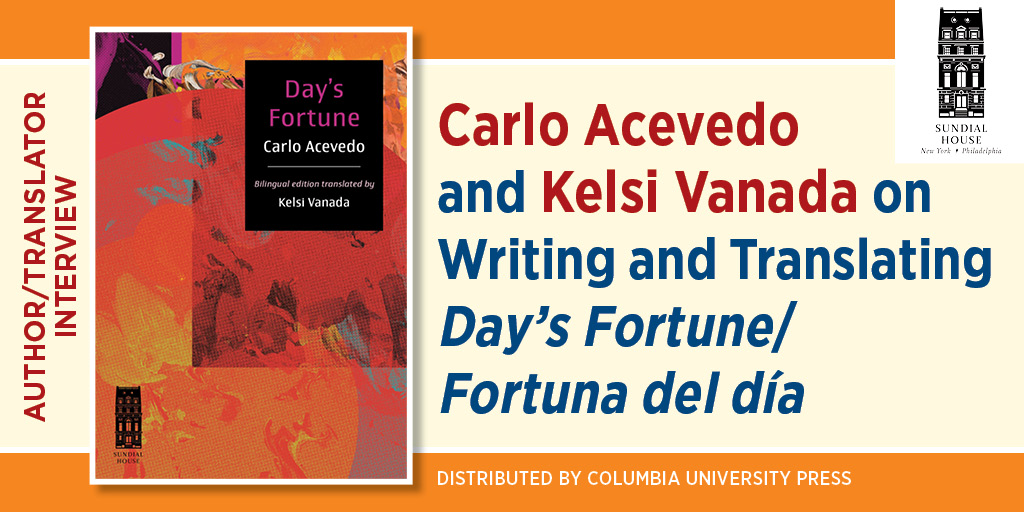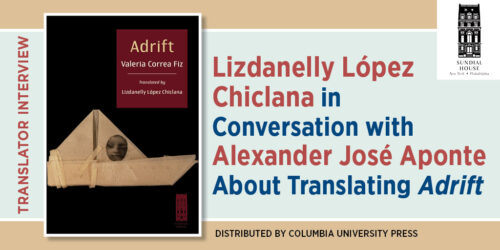Carlo Acevedo and Kelsi Vanada on Writing and Translating Day’s Fortune/Fortuna del día

Carlo Acevedo is a poet of depth, precision, and range, a strong new voice in contemporary Colombian poetry. He and translator Kelsi Vanada have known each other—and each other’s writing—for more than a decade. They met in Iowa City when Carlo was getting his MFA in creative writing in Spanish, and she was studying for MFAs from the Iowa Writers’ Workshop and the Literary Translation workshop. Their first book-length collaboration is Acevedo’s debut poetry collection, Fortuna del día/Day’s Fortune. In this conversation, Vanada and Acevedo offer insight into the writing and translation process as well as the unique value this bilingual edition brings to Spanish speakers in the United States.
Kelsi Vanada: You wrote many of the poems in this book as your MFA thesis. What was your writing process like at the time, and how has it changed?
Carlo Acevedo: Actually, I wrote all of these poems in Iowa. The book didn’t get published until a few years later because I kept working on iterations, receiving feedback from trusted readers, etc. With this specific book, I went through two fundamental phases: writing and unwriting. Most of these poems (except for the haiku, which remained as I originally wrote them) were much more extensive. After receiving helpful feedback from my editor, I realized that I needed to find the poems within the poems. Pieces that were eighteen lines long shrank to only four, and so on.
My aesthetics are pretty minimal. When I wrote these poems, minimalism manifested through briefness. Today, my poems are more extensive (even after editing them), but the language somehow became simpler, lighter. Briefness has its inherent strength, but then there’s a weight that each word has. I could spend months looking for the right adjective. That’s not the kind of precision I look for presently.
Acevedo: Ours is a longtime friendship, and we ended up working organically, starting with organizing bilingual readings in Iowa with our friends. But in general terms, how do you select your translation projects? What seduces you to invest your time and creativity in a book?
Vanada: The best thing my MFAs gave me was a community of writers to think and create with. I became friends with many of your cohort in the Spanish creative writing MFA, and started translating a number of you—projects that later became books, like Andrea Chapela’s The Visible Unseen, and Day’s Fortune, of course. A number of my other translations came about because friends from across the Spanish-speaking world recommended poets when I asked who they were reading, who were the up-and-coming poets in their countries. (That’s how I began translating Spanish poet Berta García Faet, for example.) Another way I select projects is by reading other books published by the same publisher as poets I’m working with—for instance, I’ve worked with a number of poets published by La Bella Varsovia in Spain. I’m always looking for work that prioritizes sound—and I’ve noticed that I gravitate toward translating work that is different from my own writing! Translating allows me to try on styles and voices I’d never have come up with on my own.
Vanada: What does it mean to you that this translation is published bilingually?
Acevedo: Well, I first need to consider what it means for the poems to have English versions. I must confess that, even though I love them, I cannot get close to these translations without feeling a certain strangeness. Like César Vallejo used to say, I believe that texts can be translated, but poetry cannot. This doesn’t mean that I neglect the act of translating poetry. Nothing further from the truth. It means that, as I understand poetry, it happens through how words clash with each other inside a text. This varies from language to language, so new poems emerge when translation happens.
The second thing I need to consider is that this is a bilingual edition. In a country with such a huge Spanish-speaking population, like the United States, this is so important. This will definitely enrich the encounter that these readers may have with the book. Also, for most Spanish speakers in the United States, their language is a matter of heritage and legacy.
Acevedo: I guess each translation project brings its own challenges, in terms of syntax, extension, or complexity of the content. What was the challenging and appealing aspect you faced when translating Fortuna del día?
Vanada: The most challenging aspect was also the most appealing! Translating very concise poems like yours in this book, particularly the haiku, is a challenge because each word is doing so much work in terms of content and sound. In Spanish, the haiku follow the classic 5-7-5 syllable count. But I felt that using the same form in the translation constrained me and led to bad poems. So I opted for something like Jack Kerouac’s “pops,” where there isn’t an exact syllable count, but generally there are three lines: shorter line, longer line, shorter line. I felt that this mode better allowed me to create English versions that retain the depth of feeling in your haiku, and didn’t limit the words I could choose for their sonic quality.
Vanada: The story of the book’s cover is a wonderful one—and it’s one of my favorite covers out of all my translations. Would you share how it came about?
Acevedo: Indeed, this is a very significant story for me. Diego Gamba, the Mexican artist who designed the cover, has been one of my closest friends for almost twenty years. We met in our late teens while traveling. We only spent a few months together, but the bond never faded. We dreamed about doing something together in the future. He knew he wanted to be a painter. I used to write back then, but it never crossed my mind that poetry would become such a central part of my life.
So this is our first actual collaboration, and both of us are so happy that it finally happened. A few years ago, there was a first attempt, but it never fully cooked. I was visiting him in Mexico. He was working for a TV channel doing motion graphics. He told me he wanted to use some of these poems to explore this medium. We spent a few hours going through the book, selecting possible texts. He showed me some quick sketches; I proposed further possibilities. This is a cool memory, but life gets in the way, and the motion graphics never happened.
That’s why this triple collaboration, which includes your translations, is so important to me.
Acevedo: I’ve always said that I trust you as a translator because you are a sharp poet. Your first collection of poems, Optional Saint (I love the title), was just published. Tell us about the balance between putting together your own collection and shaping your literary translation projects.
Vanada: It’s interesting, because to me, writing and translating feel somehow both intimately linked and completely separate at the same time. Maybe the difference is just the first step in the process, though: the first draft of a translation comes about differently from the way I get to the first draft of a poem. But the real work, the act of making a poem out of a messy first draft, is the same in both.
I wanted to be a writer my whole life, but I never thought I’d publish seven translations before publishing a full-length collection of my own! I’m a very slow writer of my own work, so I love having translation projects to work on. Plus, the collaborative nature of translation means this work is much more relational than my own writing, which can be very solitary. But then again, Optional Saint is chock-full of quotes from other texts, so it’s also very much a writing with. There’s even a quote from Fortuna del día in the book.
Vanada: You have a second book coming out. What can readers look forward to?
Acevedo: Yes, my second book is coming out in early 2026 in Colombia. You’ve already read the manuscript, and we’ll surely have an English version in a couple of years. This book is very different from Day’s Fortune, and from what I am writing currently. The truth is that my writing changes a lot over time, without my even noticing. It is only after accumulating several texts that I realize these transformations.
This second book is a compilation of poetic journals I wrote between 2018 and 2019. The first section is a travelogue inspired by Bashō’s travelogues and poetics, especially Narrow Road to the Interior. The second section is a set of brief prose poems/essays. The third section is a brief selection of very peculiar haiku, which I thought I would never use at all.
I believe this book gathers together any virtues my writing may have, like nothing I ever wrote before.
Categories:Author InterviewDistributed PressesHispanic Heritage MonthNational Poetry MonthNational Translation MonthPoetrySundial HouseTranslationTranslator Interview
Tags:Bilingual EditionsBilingual LiteratureCarlo AcevedoColombian LiteratureColombian PoetryContemporary PoetryCreative WritingDay's Fortune / Fortuna del díaHispanic Heritage Month 2025Kelsi VanadaLiterary TranslationMinimalism in PoetryNational Poetry MonthNational Poetry Month 2025National Translation MonthNational Translation Month 2025Poetic JournalsPoetic ProcessPoetrySound in PoetryTranslationTranslation Process




